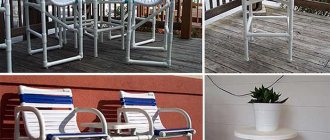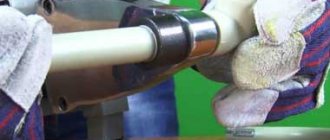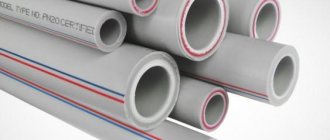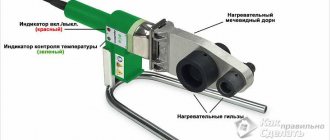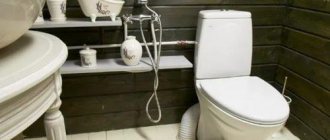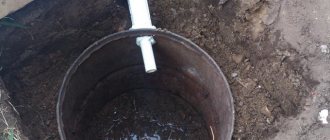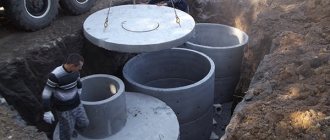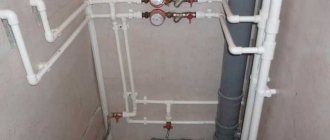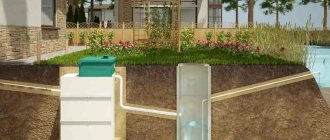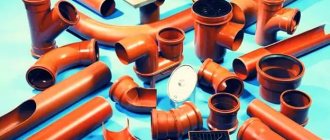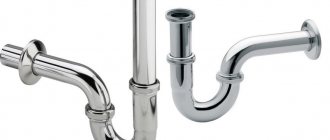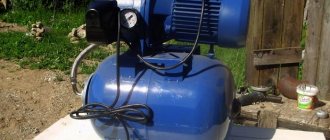- Photo: How to solder polypropylene pipes video lesson
Today, the chemical industry is developing dynamically, introducing new technologies and unique types of products to the market. The invention of such a material as high-temperature polypropylene is considered one of the most important discoveries in the field of plastics. This copolymer is a type of thermoplastic that is lightweight and has very high strength. Polypropylene is inert to most acidic and alkaline solvents, so pipes made from this material are widely used in water supply systems, heating systems and sanitary facilities.
Video tutorial on how to solder polypropylene pipes.
Basic working methods
Considering that the quality of the connecting seam largely depends on the contact area, different connection methods are used for pipes of different diameters.
Soldering of polypropylene pipes is possible:
- using a coupling (another connecting element). Suitable for products with a diameter of up to 63 mm, as well as thin-walled ones;
- directly, with a butt seam - for large-diameter, thick-walled models.
In both cases, a tight connection is ensured by the diffusion of heated plastic.
To operate, a special heating device is used to increase the temperature of the plastic to the desired level.
Important: the second installation option requires significant professional skills and, as a rule, is used only in production. At home, the coupling (fitting) soldering method is used.
The main principles of the process are shown in the master class.
How do you deal with reinforcement?
Any layer of aluminum - on the surface or deep in polypropylene - will automatically make soldering impossible. If the reinforcement is on the surface, then the pipe will not enter either the mating element or the heating coupling. This layer is peeled off to the base material.
External protection
The pipe is inserted into the shaver, then they begin to rotate, removing the interfering layer of metal. Processing is completed when the product rests on the bottom of the tool. In this case, there is no need for preliminary marking. The finished, heated pipe is inserted into the connecting element until it stops: not even a millimeter of unprotected material should be left outside.
Internal protection
Aluminum hidden in the thickness also requires trimming: metal in contact with water will soon begin to corrode, and the liquid will cause bubbles to blow. In this case, the task of the tool is to cover the end with molten polypropylene. The trimmer cuts out 1.5-2 mm of foil at the edge of the pipe, so that when mating the parts, this place will be occupied by propylene.
Pipes that have fiberglass as a protector do not need additional processing before soldering.
Equipment used
The main condition for tight and high-quality fastening of pipeline sections is simultaneous heating to the same temperature, the so-called polyfusion welding. Alternate heating is unacceptable, since the cooling time of the plastic to the temperature at which molecular diffusion stops is 6...15 seconds.
Accordingly, a special welding machine with paired heating nozzles is used for the work. Its “folk” name is “iron for welding,” obviously due to the similarity of shape. The device is also often called a soldering iron.
Heating in this apparatus is transferred from the mandrel to nozzles selected according to the nominal diameter of the pipe.
In industrial conditions, they use floor-standing rather than table-top welding machines.
Since large diameter pipes have a corresponding weight, special mounting devices are also used to hold them in the desired position during welding. Also, this device should make it possible to move the product exactly along the axis for proper joining of heated fragments.
In addition, the work requires tools for marking and cutting polypropylene pipes.
Ordinary scissors or a hacksaw do not provide such a precise and even cut, so it is better not to use them.
For large diameter pipes, a different type of cutter is used - with a movable cutting wheel.
In order for the pipe to fit better into the fitting, it must be chamfered. This can be done manually, but it is more convenient to use a bevel remover.
For products with a small diameter, you can use a manual model.
The reinforcing layer is cleaned using a shaver or trimmer.
Let's understand the types
Metal-plastic
Polyethylene
Such communications are divided into subtypes:
- Polyethylene - used for laying wiring inside buildings and external routes. They can be used on high-pressure pipe connections and at low ambient temperatures.
- PVC is used to reduce the cost of repairs.
- Metal-plastic ones are the most practical products, with a useful life of more than 50 years. Ideal option for replacing hot water supply.
The widespread use of this material is due to a number of reasons. Positive properties of such structures, in contrast to metal ones:
- Long service life.
- Low corrosivity.
- Easy to install.
- Does not require special skills.
- Environmentally friendly material.
- Economical and easy to use.
- Lightweight and easy to transport.
- Resistant to the harmful effects of microorganisms.
Features of pipes taken into account during installation
To choose the right method for soldering plastic pipes, it is necessary to take into account not only their diameter, but also the wall thickness. Therefore, before starting work, it is necessary to clarify the actual wall thickness of the selected product using markings and measurements (for verification).
For normal operation, it is necessary to clarify the data in the regulatory document according to the marking.
In general, technical data for pressure pipes made of thermoplastics is standardized by GOST R 52134-2003. However, each production has its own nuances, and for foreign manufacturers this standard does not work at all. Therefore, it is better to clarify the permissible temperature range (operating and emergency), they should not exceed the soldering temperature.
Next, according to the information received, it is necessary to clarify the heating duration when welding prepared plastic pipes and the heating temperature, as well as the cooling time of the parts.
Also, taking into account the increase in wall thickness with an increase in the nominal outer diameter, the table determines the width of the welded belt - that is, the length of the heated section. It must be the same for pipe and fitting, since diffusion (interpenetration of material particles at the molecular level) is required over the entire joined area. You can determine the width of the welded belt (the depth of insertion of the pipe into the coupling) and the size of the chamfer using the table.
Maximum insertion depth (actual width of the welded belt) without stripping.
Based on data on the type of plastic, the required heating level of the welding machine, or more precisely, the heating elements - paired nozzles, is set.
In some cases, the soldering temperature of polypropylene pipes is not 200...220 degrees Celsius, but about 260 degrees; this must be clarified with the manufacturer or seller.
Polypropylene: features of the material for pipelines
Soldering polypropylene pipe
The use of pipes made of polymer materials for organizing cold or hot water pipelines, as well as heating, is due to a number of qualities of plastics and products made from them. A common material for plumbing – polypropylene (PP) – has a number of advantages:
- temperature/pressure characteristics
- Lightweight compared to metal pipes; no corrosion
- possibility of adding a reinforcing layer
- increasing thermal resistance and maximum fluid flow pressure
- a simple method of connecting to each other, as well as to metal pipes and plumbing fixtures; cost
There is a wide range of fittings and fasteners on the market that allow you to organize a plumbing or heating system with turns, branches or connections with products made from other materials.
Elements of polymer pipelines
When deciding to use polypropylene products for indoor wiring, you should remember the characteristics of the material:
- PP pipes cannot be bent; a connecting element must be welded at each turn of the line
- thin products can be deformed at high temperatures (above +95C), you should carefully study the markings and technical specifications
- When exposed to direct sunlight, the polymer changes color (turns yellow)
- the product may crack from mechanical impact (hitting with a hammer or falling a heavy object)
In addition to pipes made of polymer material without additives, there are reinforced pipes on the market that have increased strength.
At a liquid temperature of more than +95C and a pressure of 20 atm, the lifespan of a PP pipe is significantly reduced.
Reinforced PP pipes
Reinforced polypropylene pipes in cut
To increase the strength of polypropylene products, a thin layer of reinforcing materials is added to them. The purpose of the reinforcement is to reduce linear expansion and deformation during hot water service. For strengthening use:
- Aluminum foil
- Fiberglass
The reinforcing layer can be located outside or between layers of plastic. An important feature of an aluminum-reinforced product is the risk of corrosion of the reinforcing layer if it is not cleaned during the welding process and comes into contact with hot liquid. To solder such pipes, pre-treatment is used, in which a layer of foil is cut off.
How to solder polypropylene pipes
Let's look at the process using the example of creating a water supply system in an apartment.
Important: make sure that the elements being welded have the same temperature and geometry! Violation of the correctness of the circle, uneven heating of the fragments will lead to poor quality of soldering.
For this, products with nominal diameters of 20...63 mm are used, so a hand tool will be sufficient:
- machine for manual welding of polypropylene pipes with Teflon nozzles 14...63 mm;
- manual chamfer (the principles of working with it are shown in the video);
- for reinforced pipes (PP25), a shaver will also be required to strip the outer layer;
- cutter of any suitable type;
- tape measure and marker for marking;
- degreasing composition for treating surfaces to be welded (acetone, ethyl or isopropyl alcohol, chlorethylene, trichloroethane);
- hard tarpaulin rags for cleaning heating elements.
How to weld and prepare polypropylene pipes:
- a welding machine is installed, heating nozzles are selected. Before use, they must be wiped to remove remnants of previous soldering and degreased, just like the communication parts themselves;
- pipeline sections for soldering are marked and cut to the required length;
- chamfer the pipe;
- indicate the width of the welding belt - the section that will be included in the fitting. Important - it is necessary to push the pipe into the mounting hole of the fitting until it stops. Otherwise, a gap remains between the connected pipes, which has a bad effect on the further operation of the pipeline. If it is necessary to connect parts in a certain position (for example, to obtain a right angle between two already partially assembled sections), marks are also placed for correct mating;
- for reinforced pipes, remove the top layer exactly to the width of the welding belt;
- turn on the heating apparatus. Depending on the room temperature, this will take 10...15 minutes (so you can first turn on the soldering iron, and then follow steps 2...5). The welding temperature is set to 260 degrees, wait until the green indicator of the soldering iron turns on - this means that optimal heating has been achieved;
- install the pipe and fitting on the heated nozzles. The heating duration is selected according to the diameter of the product and wall thickness;
- the heated parts are smoothly removed from the nozzles and connected at the same time. It is necessary to push the pipe into the fitting without twisting or sharp jolts;
- maintain the required initial soldering time and leave the connected elements until they cool completely (2...15 minutes).
Important: when heated, polypropylene pipes release toxins! It is necessary to ensure high-quality ventilation of the room, without directing the air flow directly to the heating area - the parts may heat up unevenly.
Figure 4 shows how the pipeline fragments look in cross-section after soldering small-diameter polypropylene pipes with your own hands - there are no visible seams or heterogeneity of the material.
Plastic soldering (welding) technology
The process consists of creating a strong joint between plastic pipes by achieving a specified temperature regime that allows the molecules of the contacting, softened workpieces to move from one to another.
The effectiveness of the work carried out is guaranteed by the exact
fulfillment of the requirements:
- Dry areas of contact between parts.
- Temperature parameters (260 - 300° C).
- Temporal characteristics.
- Wait until completely cooled.
The temperature regime and heating time intervals depend on the size (section) and composition of the pipe walls. There are standards for their control, the exposure time of the product, and the state of rest.
After the parts come into contact with the required nozzle, according to the standards, they are carefully removed and tightly connected. a small influx appears at the joint . By holding the parts tightly for 2 - 3 minutes, we obtain the desired contact. Liquid may pass here after an hour interval.
Nuances of work: how to solder plastic pipes without problems
The above instructions describe the general provisions for welding polypropylene pipes. But there are interesting points that can confuse an inexperienced master.
We work on the workbench and locally
Not all components of the future pipeline can be soldered comfortably on a prepared workbench. Of course, maximum work should be carried out there, and the point is not at all in the personal comfort of the master - this way there is less risk of incorrect connection of elements. But sometimes it is necessary to solder parts “in place”, so it is better to mark out the diagram of future communications on the wall, floor or ceiling in advance, and secure the clips that will hold the pipes in the desired position.
We fasten the welding machine
When inserting and removing heated elements, a tabletop “iron” that is not secured in any way will jerk in different directions. This leads to both problems with extracting fragments and burns (when trying to hold the falling apparatus), and its breakdown.
Therefore, it is better to fix the soldering iron on a workbench or desktop in any available way - using a “native” clamp or a clamp added to the design, self-tapping screws, and so on.
Cleaning is required!
One of the striking examples is the joining of products reinforced with aluminum not on the outside, but in the middle of the wall.
To properly solder such polypropylene pipes, it is necessary to strip the aluminum layer - but how to do this if it is between the layers of plastic and not outside?
For this, there is a special trimming tool that allows you to remove aluminum foil precisely between the layers.
The cutting edges, which “scrape out” the foil, are shifted towards the center of the product. Thanks to this, the aluminum is removed, the plastic remains in place - the pipe is ready for welding.
The photo shows what the joint looks like between prepared (right) and unprepared (left) fragments. It is clearly visible that in the first case the adhesion turned out to be dense, in the second the delamination is clearly visible. With short-term use, this defect does not matter, but for pipelines through which hot water is supplied (from a boiler or heating boiler), depressurization and failure of communications is possible.
The diagram demonstrates the consequences of a loose joint between two seemingly welded pipes, delamination of the product and swelling of the outer layer of polypropylene during operation.
Important: fiberglass reinforced pipes do not need to be stripped! This is due to the fact that the welding temperature adopted for polypropylene allows glass fiber to melt to the point of diffusion.
Correct cut
Sometimes users think that cutting the pipe obliquely - at an angle of 45 degrees - can increase the contact area and thereby strengthen the weld. This is actually true, but with this type of pruning problems arise:
- with the alignment of parts - it is difficult to correctly connect the pipe sections inside the coupling, a gap inevitably arises;
- with heating of the welded areas - an oblique cut does not allow the required fragment of the product to be completely placed on the heating element. One edge heats up less, the other more.
The last node is not welded!
This happens if an inexperienced welder inaccurately calculated the lengths and locations of pipeline fragments. When it is not possible to insert a mandrel with nozzles and a coupling between the last two elements to be welded, you can solve the problem differently - weld metal inserts into the elements to be joined.
Such a threaded pair with a union nut allows you to firmly and efficiently fasten two fragments and at the same time weld it in without any problems.
Wouldn't you, priest, chase something cheap...
An attempt to save money when purchasing pipes and fittings is fraught with leaks and swelling of pipes in the future, so it is better to purchase products from trusted manufacturers.
It is also necessary to avoid combining products from different companies - a slight difference in the composition or production technology of goods sometimes leads to critical problems in finished communications.
Other errors
Among the most “popular” errors are often found:
- excessive heating of elements. As a result, the pipe is severely deformed and closes the lumen of the coupling, thereby interfering with the free flow of water in the water supply system;
- refusal to degrease surfaces and/or clean them. In this case, diffusion does not occur over the entire surface; “islands” remain where the plastic has not fused. The result is failure of the connection when the pressure or temperature increases;
- water has not been removed (during the repair of an existing water supply system). This can be done using a rag and a warm (not hot!) stream of air from a household or construction hair dryer;
- loose connection. This happens if the pipe is not completely inserted into the fitting or the diameters do not match.
Another common mistake made by inexperienced craftsmen is not wearing protective gloves. The high heating temperature of polypropylene MUST require hand protection, and it is advisable to use gloves made of natural materials - preferably suede. They do not restrict movement and do not begin to smolder when heated, unlike cotton ones. Rubber and rubberized gloves cannot be used!
Typical mistakes are discussed in more detail in the video “How not to solder polypropylene pipes.”
First, I’ll tell you about the advantages of such pipes
- The service life, according to various manufacturers, ranges from 20 to 50 years;
- Not subject to corrosion, limescale deposits and do not require painting;
- Welding (soldering) of pipeline elements is a monolithic connection;
- Relatively elastic and not afraid of moderate physical (shock) loads;
- They dampen (smooth out) vibrations and noise of water passing through them;
- They have chemical resistance, do not allow oxygen to pass through, and are an excellent dielectric;
- Soldered connections do not require subsequent maintenance;
- Environmentally friendly and inexpensive.
Alternative to welding
In some cases, for example, in hard-to-reach places in the bathroom or other rooms, it is not possible to carry out welding work. The soldering process can be replaced by gluing the pipe to the fitting using an organic solvent. It has a very strong softening effect, but is also highly volatile.
After lubricating the end of the pipe and the internal cavity of the coupling, the plastic softens for a short period of time, and the connection can be made. Reverse polymerization begins after a few seconds.
However, this method is more suitable for PVC pipes that are less prone to thermoplasticity.
If for some reason this option is not suitable, for pipes NOT UNDER PRESSURE it is permissible to use a supercharged lighter instead of a soldering iron. This connection method is shown in the video tutorial below. It is important to understand: uniform soldering cannot be achieved precisely because of the alternating heating of parts, therefore the technology cannot be used for critical connections.
What tools are needed for soldering pipes?
To carry out welding work with plastic pipes, you will need the following tools:
- construction tape and pencil (marker) for taking measurements,
- pipe cutter or construction knife for cutting pipes,
- shaver (if welding of pipes reinforced with aluminum foil is carried out),
- file and fine-grained sandpaper for smoothing out burrs on cut pipes,
- pipe welding machine.
You will also need alcohol to degrease the structural elements in the welding areas and rags.
Recommendations for high-quality soldering of polypropylene
When performing work, consider the following process features:
- High-quality soldering is possible only on dry pipes. The presence of drops of moisture can hopelessly damage the connection;
- The attachments on the device must be secured very tightly. If they dangle, the device will very soon become unusable;
- When heated, polypropylene shrinks slightly, which is why the length of the pipe section may decrease by 1 mm. Therefore, when making calculations, make a small allowance for the length of the pipeline;
- It is better to connect pipelines in a horizontal position. This way you can avoid involuntary shifts of the connected components. How to solder polypropylene pipes in a vertical position? If such a need arises, the master holds the soldering iron, and his assistant connects the elements;
- do not overheat the soldering iron, as already at a temperature of 270 degrees polypropylene may begin to collapse;
- if it is necessary to join polypropylene and metal pipes together, then combined fittings are used. A metal pipe is attached to one end of such a fitting, and its other end is joined to a polypropylene pipe by soldering;
- in the room where work on laying the polypropylene pipeline is carried out, a positive temperature must be maintained.
Soldering nuances
Knowing the technology for connecting autonomous communications is not enough. For high-quality installation, you need to know a number of features of laying and soldering housing branches. How to solder plastic pipes correctly? To ensure professional assembly of technological buildings, it is necessary to remember some connection nuances:
- A warm-up time is provided for soldering assembly. This time ranges from 5 to 20 minutes.
- The production of in-house life support should be carried out at temperatures above zero.
- After soldering the ends, it is necessary to prevent them from scrolling or moving; it is enough to smoothly eliminate distortions. You need to let them cool. Turning the weld seam may cause a leak in the future. It takes the same amount of time to cool down as it does to solder it.
- The required power of the soldering tool is 1200 W.
- Home soldering irons are designed for soldering wires with a diameter of up to 32 cm. If you need to assemble products of large diameter, then we purchase a professional soldering device.
- There should be no gaps between the edge of the pipeline and the internal thread of the fitting. Gaps can leak under high water pressure. Excessive force when compressing elements can lead to a decrease in the clearance in the cavity and impair the performance of the entire structure.
- Residues of material from the nozzles should be removed after each pack produced. Since the nozzles have a special coating, carbon deposits should be removed with a wooden device so as not to damage the integrity of the surface. Scratches on the surface of the nozzle will worsen the technological characteristics of the device and render it unusable for further use.
